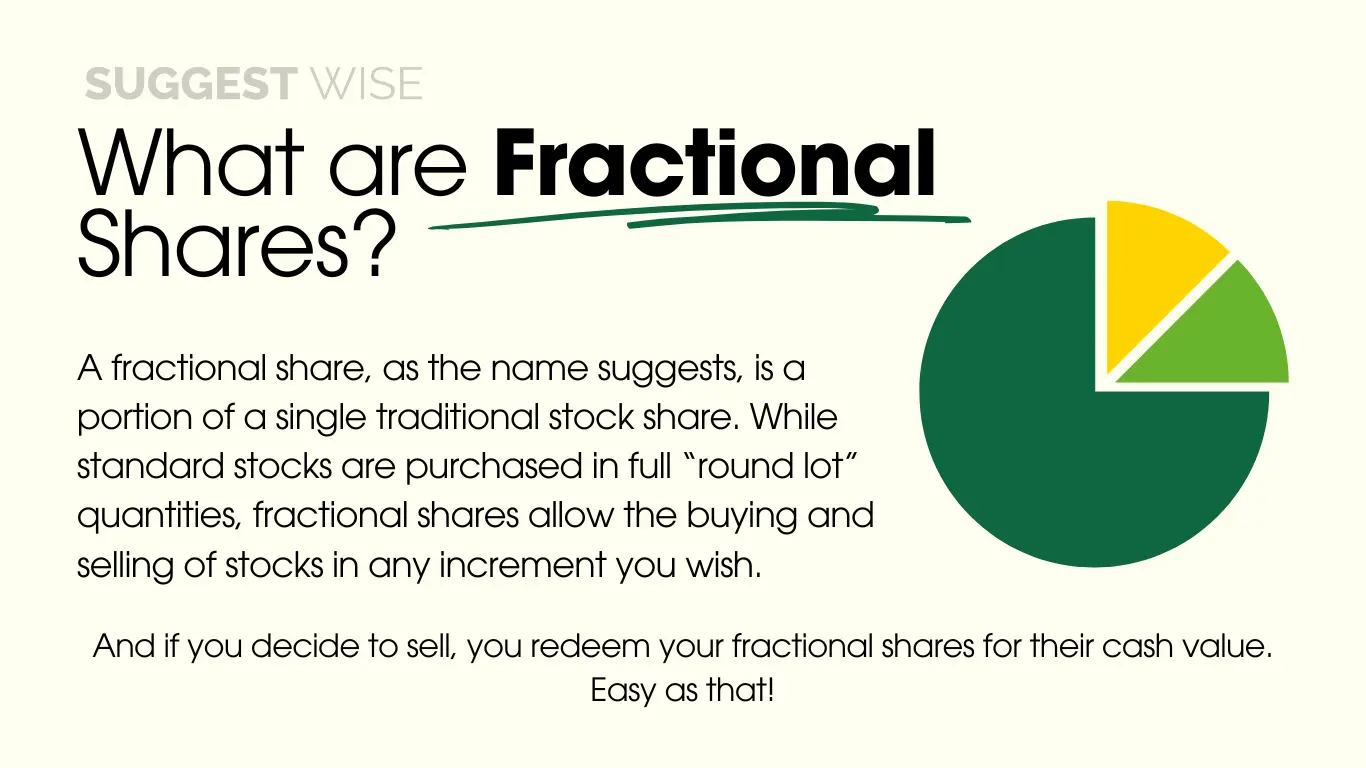
Have you ever come across a high-flying stock like Google, Amazon or Berkshire Hathaway and wished you could invest in it? But the hefty price tag reaching into the thousands of dollars made it out of your budget?
Fractional shares are breaking down those barriers and revolutionizing the way smaller investors can access the stock market. Keep reading this comprehensive guide to find out what exactly fractional shares are, what benefits they offer investors, and most importantly – how you can add these share slices to your own portfolio.
What is a Fractional Share?
A fractional share, as the name suggests, is a portion of a single traditional stock share. While standard stocks are purchased in full “round lot” quantities, fractional shares allow the buying and selling of stocks in any increment you wish.
So for example, you could invest:
- $100 in 0.5 shares of Amazon stock
- $50 in 0.25 shares
- Even $10 in 0.05 shares
You have full ownership rights in the fractional shares you purchase. So if Amazon pays a dividend, you would receive your 0.5 share’s worth.
And if you decide to sell, you redeem your fractional shares for their cash value. Easy as that!
Why Buy Fractional Shares?
There are two main reasons investors should consider fractional shares:
1. Access Expensive Stocks
Do you want a piece of hot stocks like Tesla, Booking Holdings or Chipotle, but don’t have hundreds or thousands laying around to invest in full shares?
Fractional share investing bridges that gap, letting you buy as little as $1 worth of these popular picks.
2. Diversify on a Budget
Building a well-rounded portfolio often means buying 20, 30 or even 50+ individual stocks across different sectors and industries.
Believe it or not, that used to involve shelling out tens of thousands of dollars to scoop up full shares!
With fractional shares, you can spread small amounts of capital across all the stocks you want. No more penny pinching and stock picking – just instant diversification.
Creating Fractional Shares: Stock Splits
One common way fractional shares originate is through stock splits.
When a company splits its stock, it increases the number of shares outstanding and reduces the share price, while the overall value and capitalization remains the same.
For example:
- You own 100 shares of Brand X Co. trading at $100 per share
- Brand X Co. has a 2-for-1 stock split
- You now get 200 shares at around $50 per share
If your original 100 shares was an odd number not evenly divisible, fractional shares are generated in the split. Now maybe you own 125.5 shares or 175.25 shares at the new lower price instead of a round lot.
These share slices also arise regularly from dividend reinvestment purchases and mergers using share exchange ratios.
Buying and Selling Fractional Shares
Where to Invest in Fractions
In the past, almost no brokerages accommodated fractional share orders. But thanks to mobile app disruptors like Robinhood and Webull, fractional share dealing is exploding in popularity.
Now every major online broker from Fidelity to Charles Schwab to Merrill Edge offers fractional capabilities on their platform to some degree.
You can easily invest dollar amounts as low as $1 across stocks, ETFs, and sometimes other assets like cryptocurrencies.
Executing Fractional Trades
The process of placing fractional buy and sell orders functions almost identically to normal share transactions.
Instead of punching in the number of shares, you simply enter the dollar value you wish to trade. So for instance $50, $100, or $500 worth of any asset.
The fractional portion displays out to three decimal places. You might see on your statement you bought 7.583 shares.
When selling, the fractional piece liquidates at current market value just like a standard share redemption.
The cash disburses directly into your brokerage account balance, or sweeps into an attached bank account.
Potential Downsides
While fractional shares provide exciting new opportunities, some limitations exist investors should know:
- Lack full voting rights attached to shares
- Complicates company dividend payouts
- Not transferable between brokerage accounts
- Capital gains tracking grows more complex
However for most buy-and-hold investors, the huge benefits fractional shares unlock far outweigh the drawbacks.
Bottom Line
So are you ready to unlock the fractional shares investment revolution? Sign up with an accommodating online broker today and begin slicing and dicing those overpriced stocks into affordable pieces! Start building your diversified portfolio on any budget with the power of fractions.
FAQs
Still hungry for more fractional share knowledge? Check out answers to some frequently asked questions:
Can You Buy Fractional ETF Shares?
Absolutely! All the major brokerages allowing fractional stock purchases also extend this functionality to ETFs. This conveniently allows investors to dollar cost average into diverse baskets of securities.
Are Fractional Shares Riskier?
Fractional shares carry similar risks to normal stocks depending on the specifics of companies invested in. However, some fractional positions with very small dollar amounts have higher relative commissions or wider bid-ask spreads that could Pose larger losses.
Can You Short Sell Fractional Shares?
Typically brokers do not accommodate fractional share positions when shorting stocks. The short sale asks to borrow full round lots of 100 shares which are sold immediately in the market with the goal of repurchasing later at lower levels.
Can You Buy IPO Stock as Fractional Shares?
Fractional IPO share dealing availability depends on the broker and demand levels of the listing. In some cases only full round lot orders are accepted for hot new issues. Check your broker fractional trading rules before attempting any fractional IPO buys.
